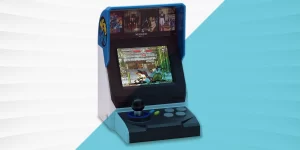Arcade game design has come a long way since the 1970s. Technological advancement allows designers to create immersive, engaging, and interactive arcade gaming devices through innovative interfaces. According to a report by Statista, the global arcade gaming market size was valued at 4.41 billion U.S. dollars in 2019 and is expected to reach 5.32 billion U.S. dollars by 2024. This growth can be attributed to the increasing adoption of advanced technologies. In this article, we will explore some of the most innovative interfaces in arcade game design that have revolutionized the industry.
Introduction to Innovative Interfaces in Arcade Game Design
Arcade game design has evolved from simple joystick and button controls to more complex interfaces, including motion sensors, touchscreens, voice recognition, and virtual reality. These interfaces allow players to interact with the game in more realistic and engaging ways.
The Evolution
The first one was Pong, released in 1972. The game had simple controls – a joystick and a button. Game designers added more buttons and joysticks to their designs as the years progressed, creating fighting games like Street Fighter and Mortal Kombat.

Motion Sensors
Motion sensors are now commonly used in arcade games. These sensors detect movement and translate it into actions within the game. This interface has revolutionized design, making games more immersive and interactive.
One popular game that utilizes motion sensors is Dance Dance Revolution. The game involves stepping on a dance pad to follow a series of arrows displayed on the screen. The game uses sensors to detect the player’s movements and translate them into actions within the game.
Touchscreens
Touchscreens have become a popular interface in design. They allow players to interact with the game by touching the screen, making gameplay more intuitive and engaging.
One popular game that utilizes touchscreens is Fruit Ninja. The game involves slicing fruit on the screen using the player’s fingers. The game uses the touchscreen interface to detect the player’s movements and translate them into actions within the game.
Voice Recognition
Voice recognition is a new and innovative interface in design. This interface allows players to control the game using voice commands, making gameplay more hands-free and immersive.
Star Trek: Voyager – The Arcade Game is a popular game that utilises voice recognition. The game involves the player commanding the USS Voyager to complete missions. The game uses voice recognition technology to detect the player’s commands and translate them into actions within the game.
Virtual Reality in Arcade Game Design
Virtual reality has become a popular interface in design. This interface allows players to immerse themselves in a virtual world, making gameplay more realistic and engaging.
One popular game that utilizes virtual reality is Star Wars: Battle Pod. The game involves the player piloting a spacecraft and engaging in dogfights with other spacecraft. The game uses virtual reality technology to create an immersive and engaging experience for the player.
In conclusion, using innovative interfaces in arcade game design has transformed the industry, offering players more immersive and interactive experiences. From motion sensors and touchscreens to voice recognition and virtual reality, game designers have pushed the boundaries of what is possible, creating more realistic and engaging games. At Arcades Australia, we offer a range of high-quality arcade systems, cabinets, and classic video game machines to help you create your own immersive gaming experience. Explore our collection today and discover the joy of arcade gaming.
You Might Also Like:

